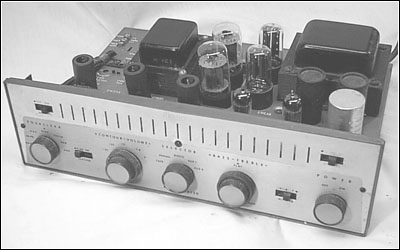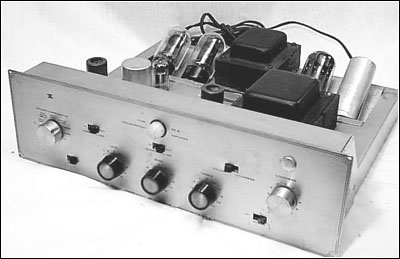Of Old Radios And Related Items--Published Monthly
Vintage Audio Amplifiers
BY WALTER H. HALL
Web Edition
Walter Hall describes two vintage audio amplifiers from the 1950s and provides some history of audio reproduction from that period. He also points out that vacuum tube audio amplifiers are still popular. (Editor)
My interest in audio amplifiers goes back many years, and from time to time, I have built and tested a variety of conventional tube-type amplifiers just for the pleasure of doing so. In the process of building and experimenting with the various approaches to achieving that elusive goal of near perfect sound reproduction, I have acquired and accumulated a few amplifiers some of which serve as historical references.
This article presents a brief history of sound reproduction in the 1950s and is centered on two vintage, tube-type, single-channel (mono) audio amplifiers that were saved from the dumpster and survived to function essentially as well as they did the day they left the factory. These amplifiers are identified as the Bogen Model DB-13, shown in Figure 1, and the Scott Model 97 B, shown in Figure 2. They were probably sold to their original owners during the 1950s.
Figure 1. The Bogen Model DB-13 amplifier.In the recent past, out of curiosity, I took a close look at these two amplifiers which had occupied space on my workshop shelves for a lot of years. Though they had been stored under favorable conditions, their condition was unknown, as far as the effect of the passage of time was concerned.
Because of the potentially destructive consequences of that long lack of use, I decided on a preoperational conditioning period to protect the electronic components, especially the electrolytic capacitors and selenium rectifiers. In addition to the conditioning period, I examined the amplifiers for other evidence of deterioration due to long- term storage. None was found. Only routine maintenance, such as cleaning and tube testing, was performed before operational testing.
Manufacturing Techniques
While the two amplifiers were probably intended for the same market, since they both could accommodate a variety of input devices such as tape players, record players and tuners, they are significantly different in mechanical and electronic details. However they both employ push-pull Type 6L6G vacuum tubes making them essentially similar from the standpoint of performance. While relatively complex by today's standards, both amplifiers bring to mind the manufacturing techniques which prevailed during the mid-20th century, before printed circuitry and automated assembly became common practice.
These two amplifiers were both manually assembled and hand-wired on the production lines typical of that period. The assembly line production of these and similar items was a relatively economical way of manufacturing at the time when young women were given specialized training to perform intricate assembly procedures. The process worked well because each operator performed a small portion of the overall assembly work so she became proficient in the specialty.
The production lines of the earlier times were a practical solution; however they were vulnerable to occasional errors by the line personnel, which could have disastrous results. For that reason, interspersed with the line workers were "checkers" whose job it was to spot errors quickly.
Other problems, such as faulty or incorrect component parts, were sometimes not discovered until the assembly had been completed, with potentially serious economic results. So the more complex the design, the greater the possibility of line interruption.
The advantages of the wired type of construction when it comes to repairs or other rehabilitation work are obvious to those of us concerned with vintage electronic equipment. While later technology made for faster and more economical manufacturing through the use of printed circuits, dip soldering, etc., and resulted in superior devices, repairability may not be the practical panacea it once was.
The Pursuit of Sound Quality
While these two amplifiers represent drastically different engineering approaches, they were both intended for users having more than an ordinary interest in sound reproduction. They both included features that optimized compensation for the variety of recording practices in use during the mid-20th century and later. The consumer demand for the ultimate sound reproduction has increased steadily over the years and probably will never be totally satisfied.
Obviously, the ultimate usefulness of audio equipment devices is the quality of the acoustic reproduction they produce. Based on listening tests of both amplifiers, the sound quality using music sources reminiscent of their time, was excellent. It was typical of well designed devices of a period when serious efforts were being made to satisfy an increasingly critical audience.
For those who may see these amplifiers as less than optimum compared with more efficient transistorized devices, it should be noted that the popularity of vacuum tube amplifiers is still alive and well in products available today. For example, a current flyer from a Midwest radio parts supplier lists two tube-type audio amplifiers, both using push-pull EL-34 output tubes. Both of these amplifiers were available "on sale" for $697.85 marked down from the original price of $748.80. The flyer also lists other vintage tubes, such as Types 6SN7 and 6SL7, both used for similar purposes in the 1950s. So the magic of the vacuum tube still persists, and no doubt, there will continue to be a ready market for these items by those who admire the acoustic realism attributable to vacuum tubes as compared to transistors.
Figure 2. The Scott Model 97 B amplifier.Walter Hall has spent nearly a lifetime in the electronics business. Although he is now retired, he still enjoys collecting and rehabilitating vintage electronic devices.
| [Free Sample] [Books, etc., For Sale] [Subscribe to A.R.C./Renew] [Classified Ads] [Auction Prices] [Event Calendar] [Links] [Home] [Issue Archives] [Book Reviews] [Subscription Information] [A.R.C. FAQ] URL = http://www.antiqueradio.com/Dec07_Hall_Amplifiers.html Copyright © 1996-2007 by John V. Terrey - For personal use only. Last revised: December 1, 2007. For Customer Assistance please contact ARC@antiqueradio.com or call (866) 371-0512 toll free Pages designed/maintained by Wayward Fluffy Publications
Antique Radio Classified |

